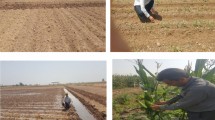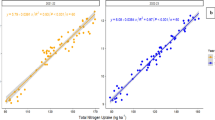Abstract
To investigate the effects of nitrogen application rate and split application method on the growth and yield of quinoa, a split plot experiment was conducted in a randomized complete block design with three replications during the two cropping seasons of 2018 and 2019. The factors studied were nitrogen application rate at four levels (0, 50, 100, and 150 kg N ha−1) and split application method of nitrogen at three levels (1- four equal splits at planting, 6–8 leaves, anthesis, and the seed filling stages; 2- three equal splits at 6–8 leaves, anthesis, and the seed filling stages; 3- two equal splits at 6–8 leaves and the anthesis stages). The results showed that the nitrogen fertilization delayed the flowering and increased the length of seed-filling period, plant height, photosynthetic pigments content, number of seeds per plant, seed yield, and aboveground biomass compared to nitrogen-free conditions. In both experimental years, two-split applications at 6–8 leaves and the anthesis stages, delayed the flowering and increased the seed-filling period as well as the content of chlorophyll a, total chlorophyll, and carotenoids compared to other methods of nitrogen splitting. In 2018, the highest seed yield was produced by two-split applications of 150 kg N ha−1, whereas in 2019, two-split applications of 100 kg ha−1 of N produced the highest seed yield. Our results indicated that two equal splits adding to 100 kg N ha−1 at 6–8 leaves and anthesis stages could be recommended to produce the optimal yield of quinoa under similar climatic conditions.



Similar content being viewed by others
Data Availability
Supporting data not available due to legal restrictions.
Notes
Instituto Boliviano de Tecnología Agropecuaria.
Promocion e Investigacion de Productos Andinos.
References
Abebe Z, Feyisa H (2017) Effects of nitrogen rates and time of application on yield of maize: rainfall variability influenced time of N application. Int J Agron 2017:1545280. https://doi.org/10.1155/2017/1545280
Adelusi AA, Oseni OM (2015) Effects of nitrogen nutrient on the photosynthetic pigments accumulation and yield of Solanum lycopersicum. AWUT-SerBio 18:131–138
Alandia G, Jacobsen SE, Kyvsgaard NC, Condori B, Liu F (2016) Nitrogen sustains seed yield of quinoa under intermediate drought. J Agron Crop Sci 202:281–291
Aleminew A, Alemayehu G, Adgo E, Tadesse T (2020) Influence of nitrogen on the growth and use efficiency of rainfed lowland rice in northwest. Ethiopia J Plant Nutr 43:2243–2258
Almadini AM, Badran AE, Algosaibi AM (2019) Evaluation of efficiency and response of quinoa plant to nitrogen fertilization levels. Middle East J Appl Sci 9:839–849
Alvar-Beltrán J, Saturnin A, Dao A, Dalla Marta A, Sanou J, Orlandini S (2019) Effect of drought and nitrogen fertilisation on quinoa (Chenopodium quinoa Willd.) under field conditions in Burkina Faso. Ital J Agrometeorol 1:33–43
Arendt EK, Zannini E (2013) Quinoa. In: Hughes S, Cox R, Hooper A, McFadyen H (eds) Cereal grains for the food and beverage industries. Elsevier, Sawston, Cambridge, pp 409–438
Bascuñán-Godoy L, Sanhueza C, Pinto K, Cifuentes L, Reguera M, Briones V, Zurita-Silva A, Álvarez R, Morales A, Silva H (2018) Nitrogen physiology of contrasting genotypes of Chenopodium quinoa Willd. (Amaranthaceae). Sci Rep 8:17524. https://doi.org/10.1038/s41598-018-34656-5
Bazile D, Pulvento C, Verniau A, Al-Nusairi MS, Ba D, Breidy J, Hassan L, Mohammed MI, Mambetov O, Otambekova M, Sepahvand NA, Shams A, Souici D, Miri K, Padulosi S (2016) Worldwide evaluations of quinoa: preliminary results from post international year of quinoa FAO projects in nine countries. Front Plant Sci 7:850. https://doi.org/10.3389/fpls.2016.00850
Belete F, Dechassa N, Molla A, Tana T (2018) Effect of split application of different N rates on productivity and nitrogen use efficiency of bread wheat (Triticum aestivum L.). Agric Food Secur 7:92. https://doi.org/10.1186/s40066-018-0242-9
Berti M, Wilckens R, Hevia F, Serri H, Vidal I, Mendes C (2000) Fertilizaction nitrogenada en quinoa (Chenopodium quinoa Willd). Cienc Investig Agrar 27:81–90
Bonifacio A, Gomez-Pando L, Rojas W (2015) Quinoa breeding and modern variety development. In: Bazile D, Bertero D, Nieto C (eds) State of the art report of quinoa in the world in 2013. FAO and CIRAD, Rome, pp 172–191
Carrotero R, Serrayo RA, Bancal MO, Perello AE, Miralles DJ (2010) Absorbed radiation and radiation use efficiency as effected by foliar diseases in relation to their vertical position into the canopy in wheat. Field Crop Res 116:184–195
Du X, Konga L, Xib M, Zhangc X (2019) Split application improving sweet potato yield by enhancing photosynthetic and sink capacity under reduced nitrogen condition. Field Crop Res 238:56–63
Erley GS, Kaul HP, Kruse M, Aufhammer W (2005) Yield and nitrogen utilization efficiency of the pseudocereals amaranth, quinoa, and buckwheat under differing nitrogen fertilization. Eur J Agron 22:95–100
Geren H (2015) Effects of different nitrogen level on the grain yield and some yield components of quinoa (Chenopodium quinoa Willd.) under Mediterranean climatic conditions. Turkish J Field Crop 20:59–64
Hattori M (1994) Effects of top dressing at heading time to barley cultivar ‘Syunrai.’ Tohoku J Agric Res 47:147–148
Hinojosa L, Matanguihan JB, Murphy KM (2018) Effect of high temperature on pollen morphology, plant growth and seed yield in quinoa (Chenopodium quinoa Willd.). J Agro Crop Sci. https://doi.org/10.1111/jac.12302
Ishfaq M, Akbar N, Zulfiqar U, Ali N, Jabran K, Nawaz M, Farooq M (2020) Influence of nitrogen fertilization pattern on productivity, nitrogen use efficiencies, and profitability in different rice production systems. Soil Sci Plant Nutr. https://doi.org/10.1007/s42729-020-00349-0
Jacobsen SE, Christiansen JL (2016) Some agronomic strategies for organic quinoa (Chenopodium quinoa Willd.). Agron Crop Sci 202:454–463
Kakabouki IP, Hela D, Roussis I, Papastylianou P, Sestras AF, Bilalis DJ (2018) Influence of fertilization and soil tillage on nitrogen uptake and utilization efficiency of quinoa crop (Chenopodium quinoa Willd.). J Soil Sci Plant Nutr 18:220–235
Leghari SJ, Wahocho NA, Laghari GM, Laghari A, Bhabhan GM, Talpur KH, Bhutto TA, Wahocho SA, Lashari AA (2016) Role of nitrogen for plant growth and development: a review. Adv Environ Biol 10:209–218
Lichtenthaler HK (1987) Chlorophylls and carotenoids, the pigments of photosynthetic biomembranes. In: Douce R, Packer L (eds.) Methods Enzymol 148:350–382. Academic Press Inc., New York
Livingston AD (2013) The whole grain cookbook: wheat, barley, oats, rye, amaranth, spelt, corn, millet, quinoa, and more, 2nd edn. Lyons Press, USA
López-Bellido L, López-Bellido RJ, Redondo R (2005) Nitrogen efficiency in wheat under rainfed Mediterranean conditions as affected by split nitrogen application. Field Crop Res 94:86–97
Mohammadi S, Heidari M, Dahmardeh M, Asgheripour MR (2016) Effects of nitrogen and arsenic on photosynthetic pigments, antioxidant enzyme activities and nutrient elements content in safflower (Carthamus tinctorius L.). J Crop Prod 8:105–120
Nakano H, Morita S (2009) Effects of seeding rate and nitrogen application rate on grain yield and protein content of the bread wheat cultivar ‘Minaminokaori’ in southwestern Japan. Plant Prod Sci 12:109–115
Saeidi SM, Siadat SA, Moshatati A, Moradi-Telavat MA, Sepahvand NA (2020) Effect of sowing time and nitrogen fertilizer rates on growth, seed yield and nitrogen use efficiency of quinoa (Chenopodium quinoa Willd.) in Ahvaz, Iran. Iranian J Crop Sci 21:354–367
Seyed Sharifi R, Namvar A (2016) Effects of time and rate of nitrogen application on phenology and some agronomical traits of maize (Zea mays L.). Biologija 62:35–45
Shahmansouri R (2015) Reaction of quinoa cultivars to nitrogen levels. Master’s thesis. Agricultural Sciences and Natural Resources University of Khuzestan, Iran. (In Persian with an abstract in English)
Shams AS (2012) Response of quinoa to nitrogen fertilizer rates under sandy soil conditions. 13th International Conference of Agronomy,Benha University (Egypt), Sept 9-10. pp 195–205
Tanaka R, Nakano H (2019) Barley yield response to nitrogen application under different weather conditions. Sci Rep 9:8477. https://doi.org/10.1038/s41598-019-44876-y
Tavoosi M, Sepahvand NA (2014) The effect of different sowing dates on yield, and phenological and morphological characteristics of different genotypes of Quinoa, a new plant, in Khuzestan. 1st International and 13th Iranian Genetics Congress, Tehran (Iran), May 24–26. Article COI code: CIGS13_0344. (In Persian with an abstract in English)
Vega-Gálvez A, Miranda M, Vergara J, Uribe E, Puente L, Martínez EA (2010) Nutrition facts and functional potential of quinoa (Chenopodium quinoa Willd.), an ancient Andean grain: a review. J Sci Food Agric 90:2541–2547
Wang ZH, Li SX, Malhi S (2008) Effects of fertilization and other agronomic measures on nutritional quality of crops. J Sci Food Agric 88:7–23
Wang D, Xu C, Ye C, Chen S, Chu G, Zhang X (2018) Low recovery efficiency of basal fertilizer-N in plants does not indicate high basal fertilizer-N loss from split-applied N in transplanted rice. Field Crop Res 229:8–16
Wang N, Wang F, Shock CC, Meng C, Qiao L (2020) Effects of management practices on quinoa growth, seed yield, and quality. Agron J 10:445. https://doi.org/10.3390/agronomy10030445
Ye T, Li Y, Zhang J, Hou W, Zhou W, Lu J, Xing Y, Li X (2019) Nitrogen, phosphorus, and potassium fertilization affects the flowering time of rice (Oryza sativa L.). Glob Ecol Conserv 20:e00753. https://doi.org/10.1016/j.gecco.2019.e00753
Funding
No funds, grants, or other support was received.
Author information
Authors and Affiliations
Contributions
Conceived, designed, and performed the experiments: ME, MJM, and HM. Statistical analysis: MJM. Contributed reagents/materials/analysis tools: ME, MJM, YH, and MG. Wrote the paper: ME and MJM. All authors read and approved the final manuscript.
Corresponding author
Ethics declarations
Conflict of interest
The authors declare that they have no competing interests.
Additional information
Publisher's Note
Springer Nature remains neutral with regard to jurisdictional claims in published maps and institutional affiliations.
Rights and permissions
About this article
Cite this article
Ebrahimikia, M., Jami Moeini, M., Marvi, H. et al. Agro-Physiological Response of Quinoa (Chenopodium quinoa Willd.) to the Nitrogen Application Rate and Split Application Method. J Soil Sci Plant Nutr 21, 3437–3450 (2021). https://doi.org/10.1007/s42729-021-00618-6
Received:
Accepted:
Published:
Issue Date:
DOI: https://doi.org/10.1007/s42729-021-00618-6




